| Author |
Message |
|
Lewis Ballard
Location: Houston, TX Joined: 27 Dec 2009
Posts: 66
|
 Posted: Thu 30 Jun, 2011 8:31 am Post subject: Hilt/tang construction of the yataghan? Posted: Thu 30 Jun, 2011 8:31 am Post subject: Hilt/tang construction of the yataghan? |
 |
|
Gentlemen:
Good day to one and all. While this is my first post, I have lurked here and at various other sharp'n'pointy forums for the last several years, and have learned a great deal. (Now, for instance, I realize that I know almost nothing.)
My two primary interests in the world of arms and armor are a) the British Isles, with an emphasis on Scotland, and b) the successive waves of Central Asian nomads who seemed to spill, every so often, out of the steppe and conquer piddly little inconsequential civilizations like China, or India, or Persia, or the Byzantine Empire. (Please note: the use of the words "piddly little inconsequential" to modify "civilizations" is very much tongue in cheek.)
My question today concerns the hilt and tang construction of the yataghan. To the best of my understanding, the yataghan was a long knife or short saber introduced by the Ottoman Turks in the 16th century, with a forward curved (or recurved) blade, lacking a guard, with grip scales which flare out into "ears" at the base of the grip, generally with a ribbon of metal between the grip scales.
However, I have been unable to locate information on the tang itself. I believe that many Central Asian derived blades use a full tang, which follows the lines of the grip. I have read of shamshirs and kilics with this type of grip. (I am also aware of the etymological problems and difficulties involved when one culture's word for "sword" or even "blade" can become associated with a particular style of sword.)
Could anyone tell me, as a general rule (always subject to exceptions!), how the tang of yataghans was constructed?
Many thanks.
|
|
  |
 |
Boris Bedrosov
Industry Professional

Location: Bourgas, Bulgaria Joined: 06 Nov 2005
Posts: 700
|
 Posted: Thu 30 Jun, 2011 2:54 pm Post subject: Posted: Thu 30 Jun, 2011 2:54 pm Post subject: |
 |
|
Hi, Lewis!
Generally, the tang of the yataghan is an integral part and natural extension of the blade, and is typical full-tang. And as you pointed correctly, it follows the lines of the grip, but not always.
Here

you may see different basic styles (with many others, which are combination of these) of the grip-ending. As you see, in some styles (particularly, when the "ears" are big and widely-flared) the tang finishes well before the end of the grip. The metal ribbon (usually of bronze, but often made of silver too) is common, but not mandatory also.
One original (unfortunately - not of my collection)

with grip style similar to #11, with "ears" flared as #5 or #6

You can see where the tang ends.
Two more pictures of the grip, where the ribbon (silver in this case) is well visible:

from the back

from the right
Another interesting point is the ornamentation of the base of the blade, which gradually transforms into a tube (under the right-most couple of stones). The scales actually are inserted into this tube and riveted towards the end of the tang.
Yet another one (not mine too - eeeeerrrrh, I'm jealous  ) )



clearly of style #19, but with metal ribbon and (relatively uncommon) metal casing of the scales. Here, the tang ends where the scales (respectively - the grip) ends.
I hope, this long explanation is worth for you.
"Everyone who has the right to wear a long sword, has to remember that his sword is his soul,
and he has to separate from it when he separates from his life"
Tokugawa Ieyasu
Find my works on Facebook:
Boris Bedrosov's Armoury
|
|
   |
 |
Glen A Cleeton

|
 Posted: Thu 30 Jun, 2011 5:06 pm Post subject: Posted: Thu 30 Jun, 2011 5:06 pm Post subject: |
 |
|
I have to disagree with the thought that yataghan ar predominantly full tang and the profile of the grip. I have studied quite a few and have had my own far enough apart during some restoration to see what is going on. My own is a tang about half the width of the grip at the blade shoulders and the scales are further divided by horn with metal (gold alloy) sheet. A close look at the spine of mine will show that.
Others are more a full profile of the tang but I have to say most are not (from what I see) The tangs of the ones showing such girth doubling and more the blade shoulders are really just as I explained. There is a filler divider as described above. The ones not embellished with (stones or not) and showing that filler/divider and that you can see the blade actually continuing are thicker scales showing the lack of the decorative filler.
Cheers
GC
 Attachment: 84.99 KB Attachment: 84.99 KB
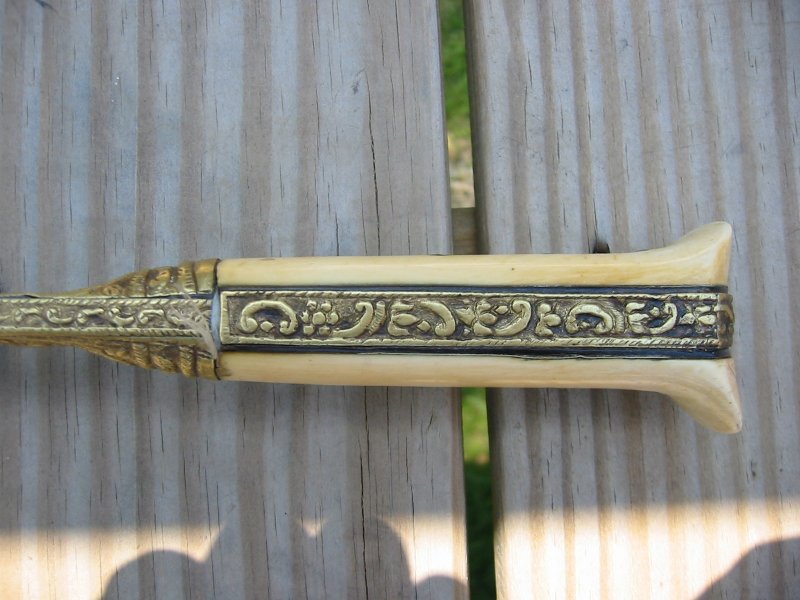
 Attachment: 61.61 KB Attachment: 61.61 KB
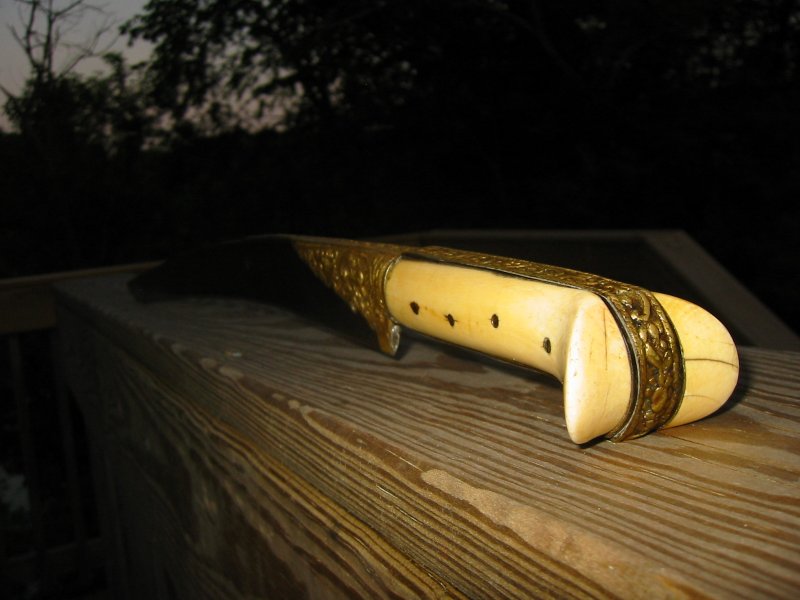
 Attachment: 48.57 KB Attachment: 48.57 KB
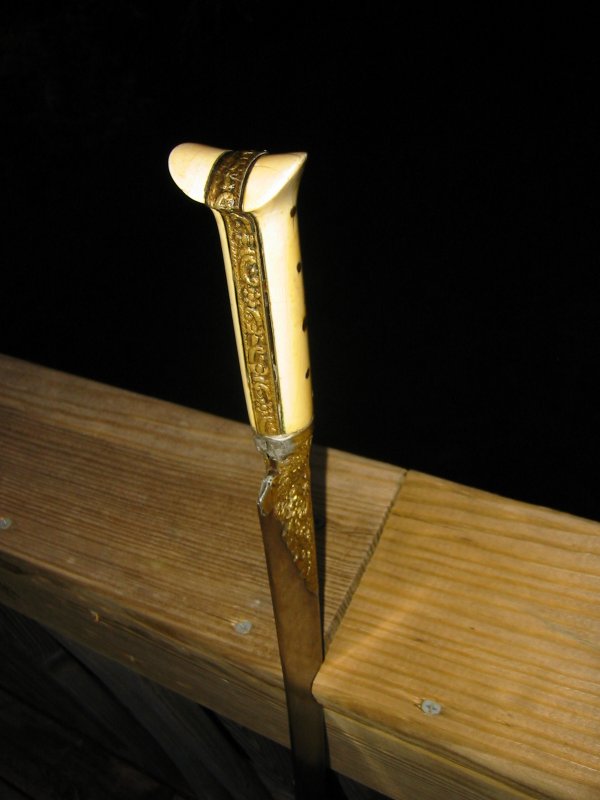
 Attachment: 10.54 KB Attachment: 10.54 KB

 Attachment: 9.43 KB Attachment: 9.43 KB

|
|
  |
 |
|
Lewis Ballard
Location: Houston, TX Joined: 27 Dec 2009
Posts: 66
|
 Posted: Thu 30 Jun, 2011 8:12 pm Post subject: Posted: Thu 30 Jun, 2011 8:12 pm Post subject: |
 |
|
Gentlemen:
Thank you both for your responses. I truly appreciate the information you have shared. Boris, may I ask the source of the (wonderful!) chart you provided? I can only hope that a book might be available, in either English or Russian, which goes into more detail about these weapons. If I am reading the chart rightly, would Glen's (also wonderful) yataghan fall under category 9? It seems to match the illustration, but as a novice I am prone to make novice mistakes.
I will confess that on first viewing, some of the handle styles seem as if they would be remarkably uncomfortable. However, I always remind myself that simply because something looks odd or awkward to me doesn't mean that it is so.
Boris, you commented that "As you see, in some styles (particularly, when the "ears" are big and widely-flared) the tang finishes well before the end of the grip." Do you mean, here, that the tang itself mostly follows the line of the ribbon, and the ears project further out? (As, apparently, in styles 4-8, 12, 14, 18 and 24?) Or am I focusing on the ribbon and not the tang? Ogromnoe spasibo! (Aware of the forum's policy on foreign languages, I hasten to translate: Many thanks, in Russian at least, and hopefully in Bulgarian as well.)
Glen, thank you so much for your response, and the lovely pictures. I have been interested in the yataghan since seeing one in a Greek restaurant in Houston, but certainly my current interest is traceable to seeing pictures of yours. As fond as I am of the other pieces in your collection, this yataghan certainly leaps out, captures the eye, and inflames the imagination. You wrote, "My own is a tang about half the width of the grip at the blade shoulders and the scales are further divided by horn with metal (gold alloy) sheet." As I read this, it means that while the tang is not the full width of the ribbon, it does have a substantial tang, over which are sandwiched in layers horn, then ivory or bone, with the gold alloy sheet as what I have been calling the ribbon? (I could be completely off in my understanding.)
Many thanks.
|
|
  |
 |
Glen A Cleeton

|
 Posted: Thu 30 Jun, 2011 9:47 pm Post subject: Posted: Thu 30 Jun, 2011 9:47 pm Post subject: |
 |
|
Hi Lewis,
The black horn is the width shown and about a centimeter deep all around the tang profile. It does not fully lie between the tang and the scales but fills the space between the tang and the metal sheet/ribbon. The scales are just as thick/thin as they look The horn is a buttress above and below the height of the tang. The tang itself is rather rectangular and squared off.
Cheers
GC
|
|
  |
 |
Boris Bedrosov
Industry Professional

Location: Bourgas, Bulgaria Joined: 06 Nov 2005
Posts: 700
|
 Posted: Fri 01 Jul, 2011 3:50 pm Post subject: Posted: Fri 01 Jul, 2011 3:50 pm Post subject: |
 |
|
| Lewis Ballard wrote: | | ......Boris, may I ask the source of the (wonderful!) chart you provided? I can only hope that a book might be available, in either English or Russian, which goes into more detail about these weapons. If I am reading the chart rightly, would Glen's (also wonderful) yataghan fall under category 9? It seems to match the illustration, but as a novice I am prone to make novice mistakes........... |
The chart is taken from the book "Turetskoe oryzhie" ("Turkish Weaponry") by Emma Astvatsaturian, last published in Saint Petersburg in 2002. The author, a renown expert on Caucasian, Balkan and Anatolian weaponry, is a curator of Eastern Weaponry Department of the State Historical Museum in Moscow.
I'm not sure, you'll be able to find the book in English. If you think this would help, the original Russian ISBN of the book is 5-901555-10-4. If you can't find it, send me a PM - I have some idea in my head.
I also think, that Glen's yataghan (congratulations - wonderful weapon) is clearly of style #9.
| Lewis Ballard wrote: | | ..........Boris, you commented that "As you see, in some styles (particularly, when the "ears" are big and widely-flared) the tang finishes well before the end of the grip." Do you mean, here, that the tang itself mostly follows the line of the ribbon, and the ears project further out? (As, apparently, in styles 4-8, 12, 14, 18 and 24?) Or am I focusing on the ribbon and not the tang?......... |
Yes, this is exactly what I mean - the tang finishes where the metal ribbon is, while the ears flare further away.
"Everyone who has the right to wear a long sword, has to remember that his sword is his soul,
and he has to separate from it when he separates from his life"
Tokugawa Ieyasu
Find my works on Facebook:
Boris Bedrosov's Armoury
|
|
   |
 |
|
Lewis Ballard
Location: Houston, TX Joined: 27 Dec 2009
Posts: 66
|
 Posted: Tue 05 Jul, 2011 7:56 am Post subject: Posted: Tue 05 Jul, 2011 7:56 am Post subject: |
 |
|
Gentlemen:
Bread cast upon the waters in a previous life seems to be returning, if not hundredfold, then at a most apropos time. A friend of a friend of a guy I knew who used to cut my hair . . . actually it's simpler than that. A friend of a friend has copies not only of Turkish Weapons but also of Weapons of the Peoples of the Caucasus . . . which he is sending me! (Do I check the mailbox twenty or thirty times a day? Why yes, yes I do.)
Although my reading comprehension in Russian is fairly good, I am sure I will lack some of the specialized vocabulary relating to arms and armor. (The Civil Code, on the other hand, that's cake.)
Returning to the Viking Sword ethnoforum, I discovered this thread http://www.vikingsword.com/vb/showthread.php?t=13677 with an example of what I assume to be a very unusual tang.
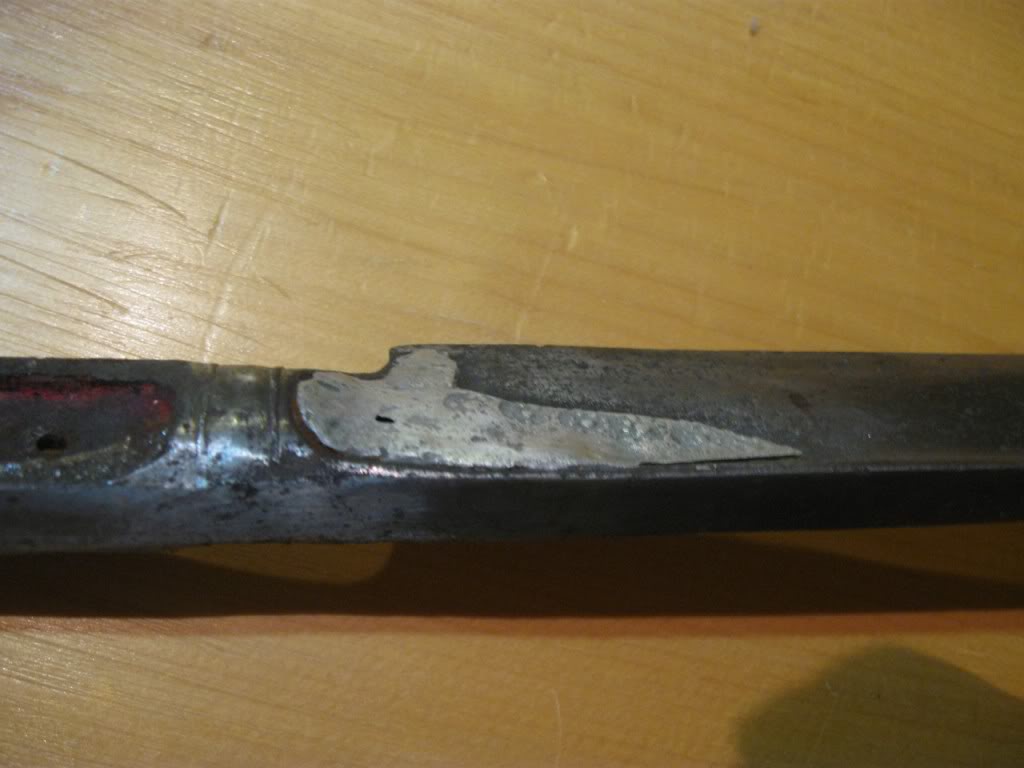
Any comments and clarifications are most welcome.
|
|
  |
 |
Boris Bedrosov
Industry Professional

Location: Bourgas, Bulgaria Joined: 06 Nov 2005
Posts: 700
|
 Posted: Tue 05 Jul, 2011 3:42 pm Post subject: Posted: Tue 05 Jul, 2011 3:42 pm Post subject: |
 |
|
Hi, Lewis!
I don't think the weapon, shown in the Viking Sword ethnoforum, is an yataghan. Without any doubt and hesitation, I classify it as a kara-kulak / ak-kulak.
First - what is a kara-kulak / ak-kulak
This is a traditional Balkan form of knife, which is similar in outlines to the yataghan. Literally, the name in Turkish means "black ears" / "white ears", respectively. This name is not connected to the construction, dimensions and so by any means, but is connected only to the material, from which the scales are made (usually, this is black buffalo horn or white bone).
This simply means, that any particular knife (kara-kulak or ak-kulak - it doesn't matter) may easy be transformed into the another type only with a change of the scales and this will take no more than a couple of hours.
Second - why I think, this is a kara-kulak / ak-kulak.
The features, mentioned in the description in the Viking Sword ethnoforum - integral bolsters, T-cross-section and thick, heavy blade all are features, typical of the kara-kulak / ak-kulak, but virtually not seen in the yataghan. Meanwhile, the yataghan is a relatively light-weight weapon, compared to its dimensions; has a slender, elegant blade with (usually, but not always) pentagonal cross-section ; has no bolsters.
In this case, the length of the blade is not a key feature. For example, my own kara-kulak (once belonged to my great-grandfather) has a blade-length of only about 22 cm (about nine inches). I have seen a lot of different kara-kulaks / ak-kulaks with blade-lengths varying from 30-32 cm (about one foot) to 45 cm (about one-and-a-half foot) to extremely long ones (although - a little bit extravagant) with a blade-length of 60-65 cm (about two feet long).
These - integral bolsters, T-cross-section and thick, heavy blade - are what's the matter.
Third - why the kara-kulak / ak-kulak appeared and why got these specific features.
During the Ottoman rule, the local non-muslim population was forbidden to wear long-blade weapons - swords first, yataghans - later. After the introduction of the yataghan (on my humble opinion - not earlier than the end of 17th - the begging of 18th C), the local craftsmen, who sought a way to break the law, while formally - keeping it, invented this form of knife. It was strong, sturdy, suit for cut and thrust, unforgivable in close-range fight and, most important, due to its heavy (with a lot of steel in it) blade, it could be easily transformed into a full-scale long-blade yataghan, when needed - during insurrections, uprisings and so.
| Lewis Ballard wrote: | | .........Although my reading comprehension in Russian is fairly good, I am sure I will lack some of the specialized vocabulary relating to arms and armor. (The Civil Code, on the other hand, that's cake.)........ |
I think, I would be able to provide some help in translation, if necessary.
"Everyone who has the right to wear a long sword, has to remember that his sword is his soul,
and he has to separate from it when he separates from his life"
Tokugawa Ieyasu
Find my works on Facebook:
Boris Bedrosov's Armoury
|
|
   |
 |
Sa'ar Nudel

|
 Posted: Wed 06 Jul, 2011 1:08 am Post subject: Posted: Wed 06 Jul, 2011 1:08 am Post subject: |
 |
|
Boris, many thanks for the well-written explanation, it helped me solve an old mystery. I always thought that kind of hilt is an off-set branch from the yataghan family. I once had a piece, clearly identified as Greek or Balkan as it was adorned with crosses and a christian year. It had the same holow cavity grip with a forged self bolster, enhanced with knurling. It was about 60cm long, forged of plain steel and had the remains of one side grip panel, made of bovine horn.
Curator of Beit Ussishkin, regional nature & history museum, Upper Galilee.
|
|
   |
 |
|
Lewis Ballard
Location: Houston, TX Joined: 27 Dec 2009
Posts: 66
|
 Posted: Wed 06 Jul, 2011 7:11 am Post subject: Posted: Wed 06 Jul, 2011 7:11 am Post subject: |
 |
|
Good day, Boris!
This is simply fascinating. While I had never heard of the ak-kulak or the kara-kulak, I was aware of the "ak" and "kara" prefixes (as in the Kara Khitai) in Turkic languages. A quick perusal of the internet turned up a Vikingsword.com thread, here: http://www.vikingsword.com/vb/showthread.php?t=4994%27%27 as well as a Youtube.com video, here: http://www.youtube.com/watch?v=7t-68whF_HQ.
I found it particularly interesting in the video to see a kara-kulak folder at the 2:00 mark, a fine example of cultural continuity and change. I am fascinated beyond reason by issues of cultural drift, such as paella-pilaf-plov-pilau (all varieties of a "meat and rice" dish from Spain to Italy to Russia to Afghanistan) and the similarities between boyar, bogatyr, bahadur and bataar.
I also appreciate the information about the distinctions between the kara-kulak and the yataghan: the integral bolster, the T-section blade, and the heaviness of the blade. Another of my fascinations, which I will touch only briefly on, is the Circassian (or Georgian, or Caucasian) shashka, which seems, like the yataghan, to have been derived from knives rather than swords. Somewhere I saw a video in which a Caucasian smith explained that the shashka was descended from the knives used to trim grape vines, and now I wonder if its origin could be traced to the Ottoman prohibition on sword use. (A topic perhaps for another day and another post.)
The more I study arms and armor, the more I am reminded of how very little we know. I had the same realization when I was studying the history of the Scottish kilt. My preconceptions were that the Scots, at least the Highlanders, had worn the kilt "so long the mind of man remembereth not." The more I researched and read, the more I realized that my premises were faulty. I believe, for instance, that the first pictorial representation of the kilt was from the 16th century . . . which wasn't really all that long ago. (And my current hypothesis for the emergence of the kilt involves the Little Ice Age and changes in animal husbandry.)
Sa'ar, thank you for your comment as well. I was beginning to fear that only Glen, Boris and I were interested in this subject!
|
|
  |
 |
Sa'ar Nudel

|
 Posted: Wed 06 Jul, 2011 11:11 am Post subject: Posted: Wed 06 Jul, 2011 11:11 am Post subject: |
 |
|
Not a problem Lewis. Although this forum is focused more on Western arms and so is my major personal interest, it is still a good thing to have a slight offset "breeze" of different types. Besides, as far as I see it, the kara-kulak is still European 
BTW as you probably know the Land of Israel has always been a cultural junction, and as part of the former Ottoman Empire we have found here all kinds of Turkic weapons. Regarding the shashka, you are probably correct - the original name derives from the Circassian language or better called Adigic (Circassian = Adiga people) sa-shka, meaning literaly 'long knife'.
Attached a photo of the last yataghan I had, it is a small knife-size, and unfortunately no photos of it outside the sheath.
 Attachment: 57.03 KB Attachment: 57.03 KB
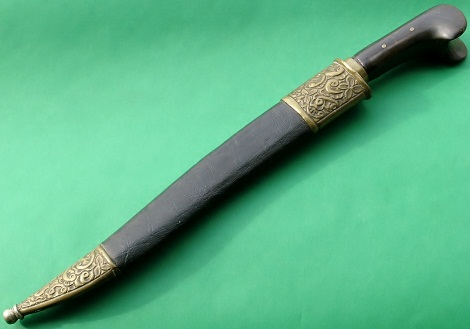
Curator of Beit Ussishkin, regional nature & history museum, Upper Galilee.
|
|
   |
 |
|
Lewis Ballard
Location: Houston, TX Joined: 27 Dec 2009
Posts: 66
|
 Posted: Wed 06 Jul, 2011 6:51 pm Post subject: Posted: Wed 06 Jul, 2011 6:51 pm Post subject: |
 |
|
Sa'ar:
That's a lovely looking yataghan! May I ask if you recall what the grips were made from? I had initially assumed that it was of a hard and dark wood, but on reflection (and with thanks to Boris) I might now cast my vote for horn.
If the yataghan and the ak-kulak/kara-kulak were "non-swords" that evolved from knives, and the shashka likewise, could the "ears" be a typical indicator of "knife like" origins? My knowledge of the kilic is fairly rudimentary, but I don't think I've ever seen a true Turkic saber that had an eared grip. (Edited to add: I distinguish here between the "spread ears" and the ball-like pommel found on shamshir, saif, etc.)
Honestly, I realized that the primary focus is on Western weaponry, but I'm a) so impressed with the knowledge level here, and b) convinced that the Ottoman Empire was not only geographically present in Europe, but also exerted such influence over patently Western regions/peoples/countries (Greece and the Balkans) that I thought I'd see what kind of response I could get here.
I just checked the mailbox----still no books! I feel like a kid waiting on his birthday!
|
|
  |
 |
Sa'ar Nudel

|
 Posted: Wed 06 Jul, 2011 11:10 pm Post subject: Posted: Wed 06 Jul, 2011 11:10 pm Post subject: |
 |
|
The grips were made of almost black horn, probably water buffalo. It also has a brass collar and ricasso, embelished in the same technique and motif as the sheath parts.
Lewis, if you use the search mode here and look for polish or hungarian/magyar saber, you will notice the further Turkish influence. In fact, even the French, British and US military forces have some kind of shamshir.
Curator of Beit Ussishkin, regional nature & history museum, Upper Galilee.
|
|
   |
 |
|
Lewis Ballard
Location: Houston, TX Joined: 27 Dec 2009
Posts: 66
|
 Posted: Sun 10 Jul, 2011 9:09 pm Post subject: Posted: Sun 10 Jul, 2011 9:09 pm Post subject: |
 |
|
| Sa'ar Nudel wrote: | The grips were made of almost black horn, probably water buffalo. It also has a brass collar and ricasso, embelished in the same technique and motif as the sheath parts.
Lewis, if you use the search mode here and look for polish or hungarian/magyar saber, you will notice the further Turkish influence. In fact, even the French, British and US military forces have some kind of shamshir. |
Sa'ar, indeed, sir! The example nearest and dearest to my heart is the Mameluke saber awarded to Presley O'Bannon during the First Barbary War, and carried by officers of the USMC since 1825, with a break around the time of the US Civil War. (There are, of course, many other examples both pre- and post-dating O'Bannon.)
The books have arrived---both Weapons of the Caucasus Peoples and Turkish Weapons, so now I'll pipe down and get to reading.
As a side note, many thanks to Glen Cleeton for his advice, quite a while back, to buy at least one book before buying a sword. Invaluable advice, and much appreciated.
|
|
  |
 |
Glen A Cleeton

|
 Posted: Sun 10 Jul, 2011 9:41 pm Post subject: Posted: Sun 10 Jul, 2011 9:41 pm Post subject: |
 |
|
Hi Lewis
| Quote: | | As a side note, many thanks to Glen Cleeton for his advice, quite a while back, to buy at least one book before buying a sword. Invaluable advice, and much appreciated. |
There are never enough books it seems but as many new questions that go unanswered.  I still tend to go on hunches with a lot of my collecting. My yataghan for instance was one of the first antiques I had purchased and lingered for several years with an incomplete description. The two long shots above were the dealer pictures and I could tell even with those, it must be some form of crucible steel. When I talked to the sale rep on the phone to buy it, he regarded it as some sort of machete thingy I still tend to go on hunches with a lot of my collecting. My yataghan for instance was one of the first antiques I had purchased and lingered for several years with an incomplete description. The two long shots above were the dealer pictures and I could tell even with those, it must be some form of crucible steel. When I talked to the sale rep on the phone to buy it, he regarded it as some sort of machete thingy  I have sincce lost web information from a site that disappeared with its counterpart quite well described, so I was comfortably place this one as Turkish and around the turn of the 19th century. I still lack good high resolution shots of the blade itself but is wonderful to view under a loupe. It is also my only sword of that corner of the world. I look at the smaller kards as something I may acquire at some point and some of the much larger sabre types are wonderful to look at. and consider. Truly though, it is two specific sword types I hunt now to round out what I see as the end of a short list. I have sincce lost web information from a site that disappeared with its counterpart quite well described, so I was comfortably place this one as Turkish and around the turn of the 19th century. I still lack good high resolution shots of the blade itself but is wonderful to view under a loupe. It is also my only sword of that corner of the world. I look at the smaller kards as something I may acquire at some point and some of the much larger sabre types are wonderful to look at. and consider. Truly though, it is two specific sword types I hunt now to round out what I see as the end of a short list.
Cheers
GC
 Attachment: 35.8 KB Attachment: 35.8 KB
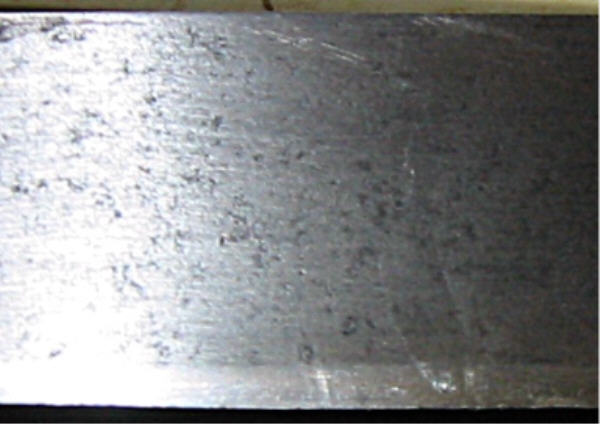
 Attachment: 19.96 KB Attachment: 19.96 KB
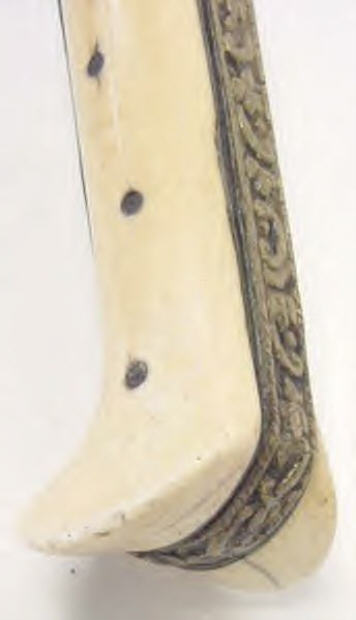
 Attachment: 25.23 KB Attachment: 25.23 KB

 Attachment: 55.58 KB Attachment: 55.58 KB
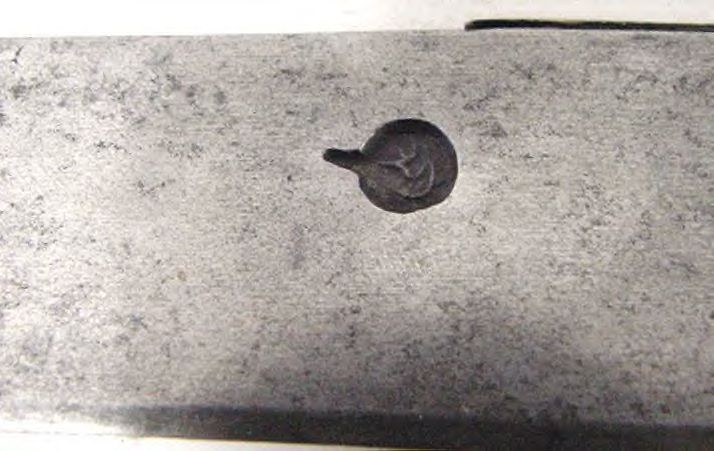
|
|
  |
 |
|
John S. Bozick
Location: Pittsburgh, PA Joined: 29 May 2009
Posts: 1
|
 Posted: Fri 05 Oct, 2012 6:08 pm Post subject: Blade construction Posted: Fri 05 Oct, 2012 6:08 pm Post subject: Blade construction |
 |
|
Thought I might tack on another question, after so much great info.
I'm looking to fabricate a reproduction of a yataghan sword, and I have a question about the blade. Is the thickness of the blade material fairly uniform up to the edge, or does it have a taper from the back edge up to the sharpened section? (Sorry, my terminology is a bit rusty so I'm not even going to try...)
Thanks in advance for the help!
"If we must pass our armour on to our posterity, let it at least be as perfect as we can make it."
- Sakakibara Kōzan
|
|
   |
 |
Glen A Cleeton

|
 Posted: Sat 06 Oct, 2012 6:12 am Post subject: Posted: Sat 06 Oct, 2012 6:12 am Post subject: |
 |
|
Hi John
On my example, the cross section is a shallow concave. for most of the blade right out to the point. There is a lot of meat though behind the edge and overall distal taper of the spine dimensions changing little until the forward, or pointy end.
I don't believe that any of the variety of these swords have a simple flat grind across the width. I do know some modern makers of all types of swords tend to punch or cut a shape out of flat stock, grind a bit (often very little), put a beveled edge on the blades and call it wonderful. That may be OK for a butter knife or Cut Co steak knife but a majority of knives and swords made in decent quality are going to have grinds going on in the third dimension.
Without actually handling period swords of any genre, there is more than a small tendency to be working in just two dimensions and then producing something that has a basic profile appearance but with few of the originals properties.
Cheers
GC
|
|
  |
 |
|
|
You cannot post new topics in this forum
You cannot reply to topics in this forum
You cannot edit your posts in this forum
You cannot delete your posts in this forum
You cannot vote in polls in this forum
You cannot attach files in this forum
You can download files in this forum
|
All contents © Copyright 2003-2025 myArmoury.com — All rights reserved
Discussion forums powered by phpBB © The phpBB Group
Switch to the Basic Low-bandwidth Version of the forum
|

